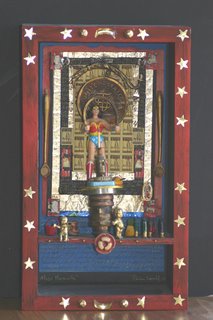

The best definition I’ve heard for wisdom is this: the ability to apply lessons from the past toward present situations. Wisdom seems to be about adapting and growing, without losing any of the treasures earned along the way. Some might say that Perla Kopeloff is a good candidate for the term "wise woman." Certainly, much of her work is infused with wise cracks -- talk with her for a while and you'll get to know those sidelong glances are a sure sign she's about to say something with two or three layers of meaning, thrown out and smoothed over almost before you get the joke.
Collage is the perfect means of expression for this multi-layered woman. Born and raised in Argentina, Kopeloff arrived in the U.S. as a young bride, and soon found herself immersed in the world of weaving. Even though she had already earned the equivalent of a master's degree in architecture, she now had a whole new culture to explore -- the weavings and baskets of the northern Appalachian region fascinated her. After apprenticing with craftspeople in the region, Kopeloff struck out on her own, gaining regional recognition as a talented weaver. To her conservative husband's dismay, the artist quickly filled the living room of their suburban home with looms and works in progress -- she was growing out of her old life. Kopeloff arrived in Taos, NM, in the early '80s, a single mother and working artist who had finally found her home. In addition to weaving, Kopeloff began papermaking and collage -- eventually, discarded objects from cultures both contemporary and ancient found their way into her work.
Kopeloff's voice has developed along with her commitment to listen to those who have been forgotten. A series of vestimentas and camisas seems to offer the landscape as a garment -- a reminder of our connection to home and to the earth, despite our efforts to leave it behind. Kopeloff's best work serves to jog the memory -- here are the priorities, intermingled with the detritus of living, sometimes dramatic and sometimes subtly covered. The purity of the idea, however, always comes through. Her shadow boxes, like altars, brim with prayers both little and big. These works reflect an inner landscape, as well as the place that holds her. Paper made from South American abaca trees, shapes and patterns that evoke Incan culture, Colorado soil, yard sale jewelry, battered parking lot trash, even pop culture icons like Wonder Woman and Batman weave their way through her work with the ease of silk thread and the substantial insistence of river reeds.
Although thousands of details are intricately woven into each of Kopeloff's works, many also reflect an emptiness -- a space where those abandoned voices can congregate. Like the best weavers, she is still using what was started long ago, revealing the truth of rich and vibrant visual effects. That exuberance is part of the same family as something more quiet and dark -- together, the collective wisdom shines.




0 Comments:
Post a Comment
<< Home